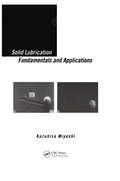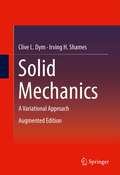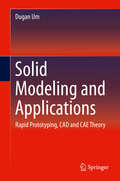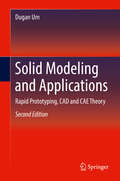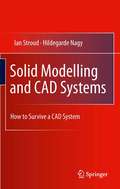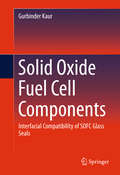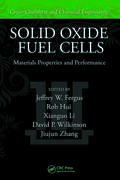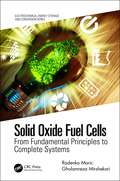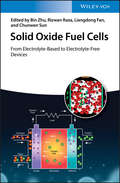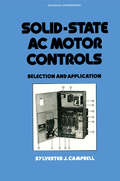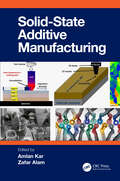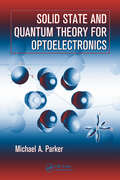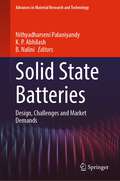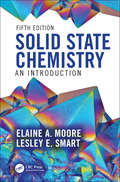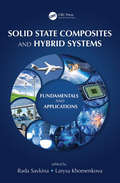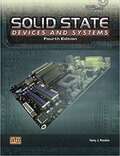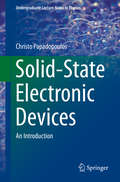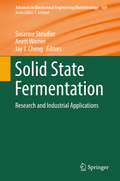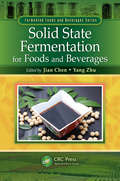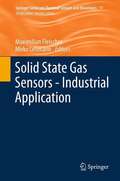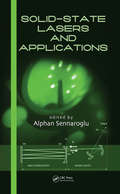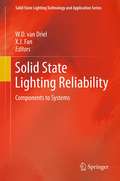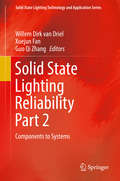- Table View
- List View
Solid Lubrication Fundamentals and Applications (Materials Engineering)
by Kazuhisa MiyoshiSolid Lubrication Fundamentals and Applications description of the adhesion, friction, abrasion, and wear behavior of solid film lubricants and related tribological materials, including diamond and diamond-like solid films. The book details the properties of solid surfaces, clean surfaces, and contaminated surfaces as well as discussing the structu
Solid Mechanics
by Clive L. Dym Irving H. ShamesSolid Mechanics: A Variational Approach, Augmented Edition presents a lucid and thoroughly developed approach to solid mechanics for students engaged in the study of elastic structures not seen in other texts currently on the market. This work offers a clear and carefully prepared exposition of variational techniques as they are applied to solid mechanics. Unlike other books in this field, Dym and Shames treat all the necessary theory needed for the study of solid mechanics and include extensive applications. Of particular note is the variational approach used in developing consistent structural theories and in obtaining exact and approximate solutions for many problems. Based on both semester and year-long courses taught to undergraduate seniors and graduate students, this text is geared for programs in aeronautical, civil, and mechanical engineering, and in engineering science. The authors' objective is two-fold: first, to introduce the student to the theory of structures (one- and two-dimensional) as developed from the three-dimensional theory of elasticity; and second, to introduce the student to the strength and utility of variational principles and methods, including briefly making the connection to finite element methods. A complete set of homework problems is included.
Solid Mechanics
by William HosfordHosford (emeritus, materials science, U. of Michigan), who has extensive publications in the field, has written a textbook focused on the mechanics of solids for students of mechanical engineering. Drawing much of the material from his earlier text, Mechanical behavior of materials, Hosford presents a clearly organized text that assumes students already have a knowledge of materials science and statics, allowing for an uncluttered presentation of the science, testing, and principles of stress and strain, elasticity, mechanical testing, plasticity, viscoelasticity, creep and stress rupture, ductility and fracture, and fatigue. Chapters on polymers, ceramics, and composites are included, as is a concluding chapter on anisotropy. Study problems are included throughout the text. Annotation ©2010 Book News, Inc. , Portland, OR (booknews. com)
Solid Modeling and Applications
by Dugan UmThe lessons in this fundamental text equip students with the theory of Computer Assisted Design (CAD), Computer Assisted Engineering (CAE), the essentials of Rapid Prototyping, as well as practical skills needed to apply this understanding in real world design and manufacturing settings. The book includes three main areas: CAD, CAE, and Rapid Prototyping, each enriched with numerous examples and exercises. In the CAD section, Professor Um outlines the basic concept of geometric modeling, Hermite and Bezier Spline curves theory, and 3-dimensional surface theories as well as rendering theory. The CAE section explores mesh generation theory, matrix notion for FEM, the stiffness method, and truss Equations. And in Rapid Prototyping, the author illustrates stereo lithographic theory and introduces popular modern RP technologies. Solid Modeling and Applications: Rapid Prototyping, CAD and CAE Theory is ideal for university students in various engineering disciplines as well as design engineers involved in product design, analysis, and validation.
Solid Modeling and Applications: Rapid Prototyping, Cad And Cae Theory
by Dugan UmThis updated, second edition provides readers with an expanded treatment of the FEM as well as new information on recent trends in rapid prototyping technology. The new edition features more descriptions, exercises, and questions within each chapter. In addition, more in-depth surface theory has been introduced in section four, with particular emphasis in surface theory. Promising cutting edge technologies in the area of rapid prototyping are introduced in section seven, MATLAB-based FEM analysis has been added in section eight, and development of the plan stress and plane strain stiffness equations are introduced as a new chapter. Revised and updated based on student feedback, Solid Modeling and Applications: Rapid Prototyping, CAD and CAE Theory is ideal for university students in various engineering disciplines as well as design engineers involved in product design, analysis, and validation. It equips them with an understanding of the theory and essentials and also with practical skills needed to apply this understanding in real world design and manufacturing settings.
Solid Modelling and CAD Systems
by Hildegarde Nagy Ian StroudSolid Modelling and CAD Systems gives users an insight into the methods and problems associated with CAD systems. It acts as a bridge between users who learn interfaces without understanding how they work and developers who create systems without understanding the needs of the users. The main feature of Solid Modelling and CAD Systems is a logical analysis of the techniques and basic solid modelling methods used in modern CAD systems. The book goes on to describe, among other subjects: two-dimensional shape definition methods,the command interface and graphics,databases and data exchange,early-phase design, andcommand files and command structures. Reading Solid Modelling and CAD Systems will help users understand the limitations of the techniques they are using and will enable practitioners to use CAD systems more efficiently. It is a valuable tool for designers, as well as for advanced undergraduate and postgraduate students. The exercises it contains allow readers to try out different aspects of the subject matter and the book also includes projects that can be used for teaching purposes.
Solid Oxide Fuel Cell Components
by Gurbinder KaurThis book examines the various interfacial reactions that take place when glass seals come into contact with components of SOFCs in reducing and oxidizing conditions. In developing an understanding of the structure and function of SOFCs, interfacial compatibility is an imperative criterion. This book addresses the technical challenges of developing sealants to avoid leakage losses at high operating temperatures, which are profoundly impactful to the efficiency of the fuel cell. This resource is important for anyone working with or studying fuel cell design and development, and is a pivotal source of cutting-edge information for research groups actively engaged in developing hermetic and stable seals which show minimum interfacial chemical reaction with interconnect and electrolyte.
Solid Oxide Fuel Cells: Materials Properties and Performance
by Jeffrey W. Fergus Rob Hui Xianguo Li David P. Wilkinson Jiujun ZhangThe First Book Centered on Materials Issues of SOFCsAlthough the high operating temperature of solid oxide fuel cells (SOFCs) creates opportunities for using a variety of fuels, including low-grade hydrogen and those derived from biomass, it also produces difficulties in materials performance and often leads to materials degradation during operatio
Solid Oxide Fuel Cells: From Fundamental Principles to Complete Systems
by Radenka MaricSolid Oxide Fuel Cells: From Fundamental Principles to Complete Systems is as a valuable resource for beginners, experienced researchers, and developers of solid oxide fuel cells. It provides a fundamental understanding of SOFCs by covering the present state-of-the-art as well as ongoing research and future challenges to be solved. It discusses current and future materials and provides an overview of development activities with a more general system approach toward fuel cell plant technology, including plant design and economics, industrial data and advances in technology. Provides an understanding of the operating principles of SOFCs Discusses state-of-the-art materials, technologies and processes Includes a review of current industry and lessons learned Offers a more general system approach toward fuel cell plant technology, including plant design and economics of SOFC manufacture Covers significant technical challenges that remain to be solved Presents the status of government activities, industry and market This book is aimed at electrochemists, batteries and fuel cell engineers, alternative energy scientists, and professionals in materials science.
Solid Oxide Fuel Cells: From Electrolyte-Based to Electrolyte-Free Devices
by Bin Zhu Rizwan Raza Liangdong Fan Chunwen SunPresents innovative approaches towards affordable, highly efficient, and reliable sustainable energy systems Written by leading experts on the subject, this book provides not only a basic introduction and understanding of conventional fuel cell principle, but also an updated view of the most recent developments in this field. It focuses on the new energy conversion technologies based on both electrolyte and electrolyte-free fuel cells?from advanced novel ceria-based composite electrolyte low temperature solid oxide fuel cells to non-electrolyte fuel cells as advanced fuel-to-electricity conversion technology. Solid Oxide Fuel Cells: From Electrolyte-Based to Electrolyte-Free Devices is divided into three parts. Part I covers the latest developments of anode, electrolyte, and cathode materials as well as the SOFC technologies. Part II discusses the non-electrolyte or semiconductor-based membrane fuel cells. Part III focuses on engineering efforts on materials, technology, devices and stack developments, and looks at various applications and new opportunities of SOFC using both the electrolyte and non-electrolyte principles, including integrated fuel cell systems with electrolysis, solar energy, and more. -Offers knowledge on how to realize highly efficient fuel cells with novel device structures -Shows the opportunity to transform the future fuel cell markets and the possibility to commercialize fuel cells in an extended range of applications -Presents a unique collection of contributions on the development of solid oxide fuel cells from electrolyte based to non-electrolyte-based technology -Provides a more comprehensive understanding of the advances in fuel cells and bridges the knowledge from traditional SOFC to the new concept -Allows readers to track the development from the conventional SOFC to the non-electrolyte or single-component fuel cell Solid Oxide Fuel Cells: From Electrolyte-Based to Electrolyte-Free Devices will serve as an important reference work to students, scientists, engineers, researchers, and technology developers in the fuel cell field.
Solid-State AC Motor Controls: Selection and Application
by Sylveste CampbellThis book discusses the current status of the solid-state AC motor controls. It treats most technical phenomena in the empirical sense, with emphasis on input-output characteristics of solid-state controls, oriented at all times to their effect on the performance of the AC motor.
Solid State Additive Manufacturing
by Amlan Kar Zafar AlamThe text focuses on discussing the solid-state deformation behavior of materials in additive manufacturing processes. It highlights the process optimization and bonding of different layers during layer-by-layer deposition of different materials in Solid-State. It covers the design, process, and advancement of solid-state additive manufacturing methods. • Covers the fundamentals of materials processing, including the stress–strain–temperature correlation in solid-state processing and manufacturing. • Discusses solid-state additive manufacturing methods, and optimization strategies for the fabrication of additive manufacturing products. • Showcases the mechanisms associated with improvement in mechanical properties of Solid-State additive manufacturing products. • Provides a comprehensive discussion on microstructural stability and homogeneity in mechanical properties. • Presents hybrid solid-state process for fabrication of multilayer components and composite materials. • Provides a detailed review of laser-based post-processing techniques The text focuses on the Solid-State additive manufacturing techniques for the fabrication of industrially relevant products. It gives in-depth information on the fundamental aspects, hybridization of the processes, fabrication of different materials, improvement in product performance, and Internet of Things enabled manufacturing. The text covers crucial topics, including hybrid Solid- State additive manufacturing, cold spray additive manufacturing, online defect detection of products, and post-processing of additively manufactured components. These subjects are significant in advancing additive manufacturing technology and ensuring the quality and efficiency of the produced components. It will serve as an ideal reference text for senior undergraduate and graduate students, and researchers in fields such as mechanical engineering, aerospace engineering, manufacturing engineering, and production engineering. .
Solid State and Quantum Theory for Optoelectronics
by Michael A. ParkerWhile applications rapidly change one to the next in our commercialized world, fundamental principles behind those applications remain constant. So if one understands those principles well enough and has ample experience in applying them, he or she will be able to develop a capacity for reaching results via conceptual thinking rather than having to
Solid State Batteries: Design, Challenges and Market Demands (Advances in Material Research and Technology)
by Nithyadharseni Palaniyandy K. P. Abhilash B. NaliniThis book offers a comprehensive analysis of novel design strategies in higher energy solid-state lithium batteries. It describes synthesis and experimental techniques to characterize the physical, chemical and electrochemical properties of the electrode and electrolytes. The book reports on electrochemical measurements of conductivity and related parameters in solid electrolytes and its interfaces. It also presents various technologies that have been used for the fabrication of all-solid-state lithium-ion batteries such as thin-film, 3D printing (additive manufacturing) and atomic layer deposition. A large part of the text focus on the description on the complete functioning and challenges with the electrochemistry of the electrodes and solid electrolyte interfaces. The book also supplies valuable insight into potential growth opportunities in this exciting market and cost-effective design tactics in solid-state assemblies.
Solid State Chemistry: An Introduction
by Elaine A. Moore Lesley E. Smart"A comprehensive guide to solid-state chemistry which is ideal for all undergraduate levels. It covers well the fundamentals of the area, from basic structures to methods of analysis, but also introduces modern topics such as sustainability." Dr. Jennifer Readman, University of Central Lancashire, UK "The latest edition of Solid State Chemistry combines clear explanations with a broad range of topics to provide students with a firm grounding in the major theoretical and practical aspects of the chemistry of solids." Professor Robert Palgrave, University College London, UK Building a foundation with a thorough description of crystalline structures, this fifth edition of Solid State Chemistry: An Introduction presents a wide range of the synthetic and physical techniques used to prepare and characterise solids. Going beyond this, this largely nonmathematical introduction to solid-state chemistry includes the bonding and electronic, magnetic, electrical, and optical properties of solids. Solids of particular interest—porous solids, superconductors, and nanostructures—are included. Practical examples of applications and modern developments are given. It offers students the opportunity to apply their knowledge in real-life situations and will serve them well throughout their degree course. New in the Fifth Edition A new chapter on sustainability in solid-state chemistry written by an expert in this field Cryo-electron microscopy X-ray photoelectron spectroscopy (ESCA) Covalent organic frameworks Graphene oxide and bilayer graphene Elaine A. Moore studied chemistry as an undergraduate at Oxford University and then stayed on to complete a DPhil in theoretical chemistry with Peter Atkins. After a two-year postdoctoral position at the University of Southampton, she joined the Open University in 1975, becoming a lecturer in chemistry in 1977, senior lecturer in 1998, and reader in 2004. She retired in 2017 and currently has an honorary position at the Open University. She has produced OU teaching texts in chemistry for courses at levels 1, 2, and 3 and written texts in astronomy at level 2 and physics at level 3. She was team leader for the production and presentation of an Open University level 2 chemistry module delivered entirely online. She is a Fellow of the Royal Society of Chemistry and a Senior Fellow of the Higher Education Academy. She was co-chair for the successful Departmental submission of an Athena Swan bronze award. Lesley E. Smart studied chemistry at Southampton University, United Kingdom. After completing a PhD in Raman spectroscopy, she moved to a lectureship at the (then) Royal University of Malta. After returning to the United Kingdom, she took an SRC Fellowship to Bristol University to work on X-ray crystallography. From 1977 to 2009, she worked at the Open University chemistry department as a lecturer, senior lecturer, and Molecular Science Programme director, and she held an honorary senior lectureship there until her death in 2016. At the Open University, she was involved in the production of undergraduate courses in inorganic and physical chemistry and health sciences. She served on the Council of the Royal Society of Chemistry and as the chair of their Benevolent Fund.
Solid State Composites and Hybrid Systems: Fundamentals and Applications
by Rada Savkina Larysa KhomenkovaSolid state composites and hybrid systems offer multifunctional applications in various fields of human life, demonstrating solutions to the key problems of the environment, human health, biology, medicine, electronics, energy harvesting and storage. Exploring this innovative field of research, this book details the wide range of materials, techniques, and approaches utilised in composite and hybrid structures in recent years. It will be of interest not only for experienced researchers but also for postgraduate students and young researchers entering the fields of nanoscience, material sciences, and bioengineering. Features: Contains the latest research developments in the materials, techniques, patents, and approaches in the field Includes both fundamental aspects and applied research Edited by two highly experienced researchers
Solid State Devices and Systems
by Gary J. RockisThis textbook presents a comprehensive overview of solid state devices and circuits. Component and circuit construction, operation, and installation are supported by detailed illustrations. Practical applications are included.
Solid-State Electronic Devices
by Christo PapadopoulosA modern and concise treatment of the solid state electronic devices that are fundamental to electronic systems and information technology is provided in this book. The main devices that comprise semiconductor integrated circuits are covered in a clear manner accessible to the wide range of scientific and engineering disciplines that are impacted by this technology. Catering to a wider audience is becoming increasingly important as the field of electronic materials and devices becomes more interdisciplinary, with applications in biology, chemistry and electro-mechanical devices (to name a few) becoming more prevalent. Updated and state-of-the-art advancements are included along with emerging trends in electronic devices and their applications. In addition, an appendix containing the relevant physical background will be included to assist readers from different disciplines and provide a review for those more familiar with the area. Readers of this book can expect to derive a solid foundation for understanding modern electronic devices and also be prepared for future developments and advancements in this far-reaching area of science and technology.
Solid State Fermentation: Research and Industrial Applications (Advances in Biochemical Engineering/Biotechnology #169)
by Susanne Steudler Anett Werner Jay J. ChengThis book reviews the wide range of products and applications of solid state fermentation as well as the development of this cultivation technology over the last years. In this book, readers will also learn about the challenges of solid state fermentation, including process management, reactor design, scale-up and the formation of process-specific products. Solid fermentation is a traditional cultivation technique of food technology and involves all cultivations of microorganisms on a solid substrate without free liquid phase. In the course of development of Biotechnology it was replaced by liquid cultivation mainly in the western countries. Over the past few years, solid-state fermentation is now becoming more important and has moved more back into focus. Especially, it is suitable for the cultivation of filamentous organisms, like ascomycetes and basidiomycetes, but also for various yeasts and bacteria. The products and applications of solid-state fermentation are as diverse as the microorganisms. They range from enzyme production to the production of antibiotics and pigments to the use in environmental technology and energy production.
Solid State Fermentation for Foods and Beverages (Fermented Foods and Beverages Series #2)
by Jian Chen Yang ZhuAlthough one of the oldest microbial technologies used in food processing, solid-state fermentation (SSF) had, until recently, fallen out of favor. However, based on a series of established mathematical models, new design concepts for SSF bioreactors and process control strategies have been proposed, allowing SSF technology to reach new levels. Sol
Solid State Gas Sensors - Industrial Application
by Maximilian Fleischer Mirko LehmannGas sensor products are very often the key to innovations in the fields of comfort, security, health, environment, and energy savings. This compendium focuses on what the research community labels as solid state gas sensors, where a gas directly changes the electrical properties of a solid, serving as the primary signal for the transducer. It starts with a visionary approach to how life in future buildings can benefit from the power of gas sensors. The requirements for various applications, such as for example the automotive industry, are then discussed in several chapters. Further contributions highlight current trends in new sensing principles, such as the use of nanomaterials and how to use new sensing principles for innovative applications in e.g. meteorology. So as to bring together the views of all the different groups needed to produce new gas sensing applications, renowned industrial and academic representatives report on their experiences and expectations in research, applications and industrialisation.
Solid State Gas Sensors - Industrial Application (Springer Series on Chemical Sensors and Biosensors #11)
by Maximilian Fleischer Mirko LehmannGas sensor products are very often the key to innovations in the fields of comfort, security, health, environment, and energy savings. This compendium focuses on what the research community labels as solid state gas sensors, where a gas directly changes the electrical properties of a solid, serving as the primary signal for the transducer. It starts with a visionary approach to how life in future buildings can benefit from the power of gas sensors. The requirements for various applications, such as for example the automotive industry, are then discussed in several chapters. Further contributions highlight current trends in new sensing principles, such as the use of nanomaterials and how to use new sensing principles for innovative applications in e.g. meteorology. So as to bring together the views of all the different groups needed to produce new gas sensing applications, renowned industrial and academic representatives report on their experiences and expectations in research, applications and industrialisation.
Solid-State Lasers and Applications (Optical Science and Engineering)
by Alphan SennarogluBecause of the favorable characteristics of solid-state lasers, they have become the preferred candidates for a wide range of applications in science and technology, including spectroscopy, atmospheric monitoring, micromachining, and precision metrology. Presenting the most recent developments in the field, Solid-State Lasers and Applications focuses on the design and applications of solid-state laser systems.With contributions from leading international experts, the book explores the latest research results and applications of solid-state lasers as well as various laser systems. The beginning chapters discuss current developments and applications of new solid-state gain media in different wavelength regions, including cerium-doped lasers in the ultraviolet range, ytterbium lasers near 1µm, rare-earth ion-doped lasers in the eye-safe region, and tunable Cr2+:ZnSe lasers in the mid-infrared range. The remaining chapters study specific modes of operation of solid-state laser systems, such as pulsed microchip lasers, high-power neodymium lasers, ultrafast solid-state lasers, amplification of femtosecond pulses with optical parametric amplifiers, and noise characteristics of solid-state lasers. Solid-State Lasers and Applications covers the most important aspects of the field to provide current, comprehensive coverage of solid-state lasers.
Solid State Lighting Reliability
by W.D. van Driel X. J. FanSolid State Lighting Reliability: Components to Systems begins with an explanation of the major benefits of solid state lighting (SSL) when compared to conventional lighting systems including but not limited to long useful lifetimes of 50,000 (or more) hours and high efficacy. When designing effective devices that take advantage of SSL capabilities the reliability of internal components (optics, drive electronics, controls, thermal design) take on critical importance. As such a detailed discussion of reliability from performance at the device level to sub components is included as well as the integrated systems of SSL modules, lamps and luminaires including various failure modes, reliability testing and reliability performance.
Solid State Lighting Reliability Part 2
by Willem Dirk van Driel Xuejun Fan Guo Qi ZhangIn the past four years we have witnessed rapid development in technology and significant market penetration in many applications for LED systems. New processes and new materials have been introduced; new standards and new testing methods have been developed; new driver, control and sensing technologies have been integrated; and new and unknown failure modes have also been presented. In this book, Solid State Lighting Reliability Part 2, we invited the experts from industry and academia to present the latest developments and findings in the LED system reliability arena. Topics in this book cover the early failures and critical steps in LED manufacturing; advances in reliability testing and standards; quality of colour and colour stability; degradation of optical materials and the associated chromaticity maintenance; characterization of thermal interfaces; LED solder joint testing and prediction; common failure modes in LED drivers; root causes for lumen depreciation; corrosion sensitivity of LED packages; reliability management for automotive LEDs, and lightning effects on LEDs. This book is a continuation of Solid State Lighting Reliability: Components to Systems (published in 2013), which covers reliability aspects ranging from the LED to the total luminaire or system of luminaires. Together, these two books are a full set of reference books for Solid State Lighting reliability from the performance of the (sub-) components to the total system, regardless its complexity.
